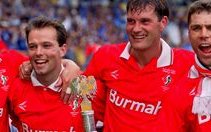Swindon Town Football Club are an English football team. As of 2006-07, they play in Football League Two. They play at the County Ground, Swindon, which has an all-seated capacity of just over 15,000.
1881-1945
Founded in 1881, though some earlier records suggest the club may have been founded two years earlier 1879, the team turned professional in 1894 and joined the Southern League which was founded in the same year.
The most notable early player was Harold Fleming who scored 202 goals in 332 games for Swindon between 1907 and 1924 and was capped nine times for England. Today in Swindon there is statue of the footballer and the stretch of road Fleming Way is named in his honour.
In the 1909?1910 season Swindon reached the FA Cup semi-finals, losing to Newcastle United who subsequently defeated Barnsley in the final. Barnsley and Swindon were invited to compete for the Dubonnet Cup in a match played at the Parc des Princes Stadium in Paris. The result was a 2?1 victory for Swindon with Harold Fleming scoring both of the Town?s goals. One of football?s larger trophies, the Dubonnet Cup weighs in at nearly a hundredweight.
In the following season, 1910?1911, the team won the Southern League championship, earning them a Charity Shield match with the Football League champions Manchester United. This, the highest-scoring Charity Shield game to date, was played on 25 September 1911 at Stamford Bridge. Swindon scored four goals, while United managed eight.
In 1911?1912 the team again reached the FA Cup semi-finals, this time being knocked out by Barnsley after a replay.
Swindon became Southern League champions for the second and last time in 1914.
In 1920 Swindon entered the Football League as a founding member of Division Three and defeated Luton Town F.C. 9?1 in their first game of the season. This result stands as a record for the club in League matches.
In 1921 the Third Division became the Third Division South: a division from which Swindon was never to be promoted or relegated, although it did have to apply for re-election at the end of the 1932?1933, 1955?1956 and 1956?1957 seasons.
During World War II a number of players were enlisted into the arm
1945-1991
The post-war era saw Swindon competing in the lower divisions of the English League. Though in 1963 the club was promoted to the Second Division after finishing 2nd in Division 3, season 1962-63. The club was relegated two years later. However the club found shrewd managers in Bert Head and Danny Williams. In 1969 Swindon beat Arsenal 3-1 to win the League Cup for the first and only time in the club’s history. This year also saw Swindon go back to the second division after again finishing 2nd in the 3rd division on goal average with Watford and Swindon joint on 64 points. The scorer of two of the goals in the League Cup final, Don Rogers, was also in form to help Swindon beat SSC Napoli 3-0 to win the Anglo-Italian Cup in 1970. Swindon also beat AS Roma 5-3 over two legs to win the inaugural Anglo-Italian League Cup Winners’ Cup.
Swindon reached their lowest ebb in 1982 when they were relegated to the Fourth Division, and did not leave the league’s basement division until 1986 when they were Fourth Division champions. A year later they won the Second Division relegation/Third Division promotion playoffs to achieve a second successive promotion. Macari left in 1989 to take charge of West Ham United. Veteran midfielder Ossie Ardiles replaced Macari and in his first season they were Second Division playoff winners. But Swindon later admitted 36 charges of breaching league rules (a scandal which saw their chairman Brian Hiller being given a six-month prison sentence and chief accountant Vince Farrar being put on probation) and were relegated to the Third Division – giving Sunderland A.F.C. promotion to the First Division and Tranmere Rovers F.C. to the Second Division. An appeal saw Swindon being allowed to stay in the Second Division. But their form dipped in 1990-91 and by the time Ossie Ardiles moved to Newcastle United in March 1991, they were just above the Second Division drop zone. Former Tottenham midfielder Glenn Hoddle, 33, was named as Swindon’s new pl
1992-2002
Swindon progressed well during Hoddle’s first full season as manager and just missed out on the Second Division playoffs. A year later they beat Leicester City 4-3 in the new Football League Division One playoff final to achieve promotion to the Premiership – bringing top division football to the club for the first time.
Hoddle moved to Chelsea during the summer of 1993 and was replaced by assistant John Gorman, but Swindon never adjusted to the pace of Premiership football. They went down with a dismal record of just five wins, as well as having conceded 100 goals – the latter record has yet to be broken. Gorman was sacked in November 1994 with Swindon struggling near the foot of Division One. 33-year-old Manchester City midfielder Steve McMahon took over, and despite a run to the League Cup semi finals Swindon suffered a second successive relegation and slipped into Division Two. They might have survived if high scoring Norweigan striker Jan Aage Fjortoft had stayed, but he was sold to Middlesbrough on transfer deadline day.
McMahon succeeded in getting Swindon back into Division One at the first attempt, as they won the Division Two championship in 1996. But the club’s financial state was getting more precarious and Swindon could not afford to build a side which might be able to win promotion to the Premiership, and McMahon was dismissed in September 1998 with Swindon battling against relegation back to Division Two. He was replaced by Jimmy Quinn, who had taken Reading to the Division One playoff final in 1995.
Swindon’s financial problems continued throughout the 1999-2000 season and their future was safeguarded just before the end of the campaign, thanks to a takeover by Terry Brady. But it was too late to save Swindon’s place in Division One – they had already been relegated in bottom place. The club’s new owner sacked manager Jimmy Quinn and appointed Colin Todd – who had won promotion to the Premiership with Bolton in 1997 – as manager, in hop
2002-Present
Parkin was joined by former Birmingham and Watford striker Tommy Mooney for the 2003-04 season, and their prolific goalscoring combined helped Swindon achieve a place in the Division Two playoffs, but they lost on penalties to eventual winners Brighton in the playoff semi finals.
Swindon failed to make the playoffs in 2004-05 and Parkin was transferred to Championship side Ipswich Town. Andy King drafted in QPR forwards Jamie Cureton and Tony Thorpe, but neither player made much of an impact and it was soon clear that Parkin would be a very difficult player to replace successfuly.
A mixed start to the 2005-06 League One campaign cost Andy King his job, and youth development officer Iffy Onuora took over at least until the end of the season.
It was reported that Ron Atkinson was being brought in to support Iffy Onuora in December 2005, and Atkinson and the club appeared to confirm this. However it later transpired that Atkinson’s role was simply as part of a Sky One documentary about the club being filmed at the County Ground. Filming has now been stopped due to excessive demands on the managment team.
Swindon have achieved mixed results since Onuora’s appointment and with 2 games to go during the 2005/2006 League One season they effectively found themselves relegated to League Two. This is the first time in 20 years the club will play at this level. Swindon also become the first Ex-Premiership side to go from the top divison in the English Game to the Bottom
The County Ground
Ground Name: County Ground
Capacity: 15,728
Address: Swindon Town Football Company, County Road, Swindon Wiltshire, SN1 2ED
Main Telephone No: 0870-443-1969
Main Fax No: 01793-333-703
Ticket Office: 0870-443-1894
Ticket Office Fax: 01793-333-780
Year Ground Opened: 1896
Pitch Size: 110 x 70 yards
Average attendance (2005/2006):5442
Last Major Construction: 1993, construction of the Intel(Nationwide) stand, and demolision of the old Shrivenham Road Stand.
Record Attendance: 32,000 vs Arsenal, FA Cup Third Round, 15th January 1972.
Club Achievements
DIVISION TWO CHAMPIONS 1995/1996
SWINDON TOWN’S ONLY SEASON IN THE PREMIER LEAGUE 1993/1994
DIVISION ONE PLAY-OFF WINNERS 1992/1993 – Swindon Town beat Leicester City 4-3 to gain promotion to the FA Carling Premier League
DIVISION TWO PLAY-OFF WINNERS 1989/1990 – Perhaps the best football ever played by a Swindon team. Town edged Sunderland 1-0 to gain promotion to the old First division. Swindon Town were later relegated to Division 3 after illegal payments. On appeal Town were relegated only to Division 2.
DIVISION THREE PLAY-OFF WINNERS 1986/1987 – Swindon Town beat Gillingham 2-0 at Selhurst Park to gain promotion to the old second division.
DIVISION FOUR CHAMPIONS 1985/1986
ANGLO-ITALIAN CUP WINNERS 1969/1970
ANGLO-ITALIAN CUP WINNERS CUP WINNERS 1969/1970
LEAGUE CUP WINNERS 1968/1969 – Swindon Town’s greatest achievement. Beating Arsenal at Wembley to lift the League Cup.
Ticket Prices
The 2006/07 ticket prices are as follows
Arkells/Nationwide Stands
Pay In Advance:
Adults: 18.00
Concessions: 13.00
Junior: 7.00
Pay On The Day
Adults: 20.00
Concessions: 15.00
Junior: 9.00
Town End Stand
Pay in Advance and Pay on The Day
-Adults:15.00
Concessions: 12.00
Junior: 7.00
Disabeled Enclosure
Tickets remain the same whether bought in advance or on the day.
-Adults:18.00
Concessions: 12.00
Junior: 4.00
kids Under 7 Go Free.



